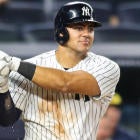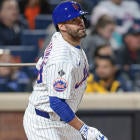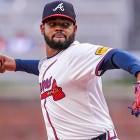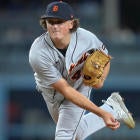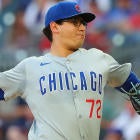After less than 170 innings at the minor-league level, Phillies top pitching prospect Aaron Nola is ready for the majors, and will make his major-league debut Tuesday against the Rays. That is a pretty soft landing, as the Rays rank just 26th in the majors in runs per game, so Nola could have a very good debut ahead of him. Beyond that, what should Fantasy owners be expecting from the No. 7 overall pick from last year's draft?
If he was a lefty, Nola would probably be tagged with the backhanded compliment that is the "crafty" designation. Most prospect analysts have put a limit on Nola's ceiling, with few expecting him to be more than a No. 3 starter in the end. So, why did Baseball America still rank him as the No. 12 prospect in baseball when they recently released their midseason top-50? Let's let them explain it:
Nola is like investing in Treasury bills. He’s a very safe starting pitching prospect who is big league ready
Nola struck out more than a batter per inning just once in his three seasons at LSU, and has done it just once in four stops through the minors, his 32 2/3-inning cameo at Triple-A Lehigh Valley this season. Overall, he hasn't put up huge strikeout numbers in the minors, averaging just 7.5 batters per nine with a middling 21.1 strikeout percentage.
So, Nola doesn't have the upside of a Lance McCullers or a Noah Syndergaard; he doesn't have a high-90's fastball to blow by hitters, nor does he have a knee-buckling breaking to bury in the dirt and make professional hitters look like fools. All Nola knows how to do is pitch.
Nola has walked just 1.5 batters per nine innings in his minor-league career, an elite mark even when you don't consider the fact that most pitchers his age are still trying to figure out how to, you know, pitch. He has an advanced feel for pitching that belies his age and experience level, and it makes his stuff play up even more than it otherwise might. Nolas has more than six strikeouts in just five of his 18 starts this season, but also has more than two walks in just one.
So the good news is, Nola isn't going to give hitters a free pass; he's going to make them beat him. The bad news is, that might happen more often than you might hope this season, because of where he is pitching and who will be behind him. Nola has just a 39.3 percent groundball rate in his time in the minors, and ranked just 132nd out of 188 pitchers between Double-A and Triple-A this season in that category. He isn't some kind of extreme fly ball pitcher, but he seems firmly below average when it comes to groundball rate, which could lead to homer issues playing at Citizens Bank Park.
Add in the fact that the Phillies rank dead last in the majors in defensive efficiency per BaseballProspectus.com and FanGraphs.com's Defensive Runs Saved, and we have a pitcher who could give up more home runs than you'd like and probably won't get much help from his defense either. Those factors aren't a dealbreaker -- Cole Hamels has been pretty good for the Phillies! -- but it's hard to be a very good pitcher if you have those working against you and don't strike many batters out.
Nola is a top prospect for a reason, but it isn't because many see star potential in him. Sure, sometimes you have a Jacob deGrom situation where a low-ceiling prospect exceeds all reasonable expectations when he gets to the majors. But, deGrom is an outlier for a reason, and his success so far has been entirely unexpected.
The most likely outcome for Nola is probably that he is a roughly league average pitcher from this point on, who eats innings and helps you in WHIP and strikeouts by virtue of going out and giving six innings every night. That may end up selling him a bit short, but his minor-league track record doesn't suggest immediate stardom. Still, in a world in which Chris Young is owned in 67 percent of CBSSports.com leagues and Mike Montgomery has become one of the hottest waiver-wire adds of the season, there should be room for Nola on your roster.













